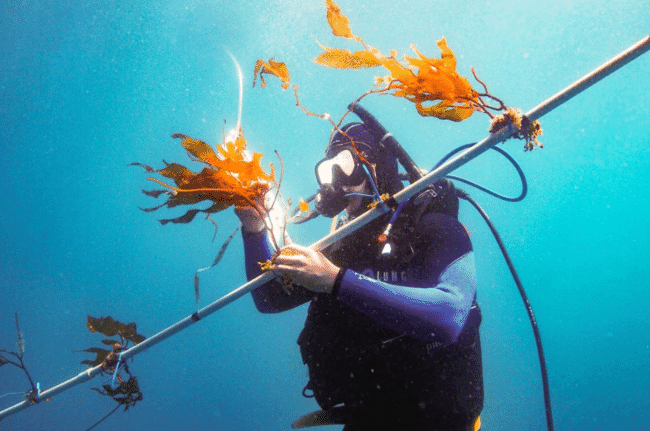
Raising and lowering the kelp dramatically accelerates its growth, proving the potential for mass-produced seaweed to power vehicles with biofuel harvested from the ocean. © David Ginsburg, USC
Scientists at the USC Wrigley Institute for Environmental Studies on Santa Catalina Island, working with Marine BioEnergy, have been testing a “kelp elevator” that optimises growth by raising and lowering the seaweed to different depths, according to a press release from USC.
The team’s newly published findings suggest it may be possible to use the open ocean to grow kelp as a low-carbon biofuel. Biofuels currently account for 7 percent of US transport fuels, but the researchers point out that generating biofuels from feedstocks – like corn and soybeans – requires the use of pesticides and fertilisers on the crops, which can end up polluting streams, rivers and lakes.
“Forging new pathways to make biofuel requires proving that new methods and feedstocks work. This experiment on the Southern California coast is an important step because it demonstrates kelp can be managed to maximize growth,” said Diane Young Kim, an author of the study, who is associate director of special projects at the Wrigley Institute.
Pioneering kelp farming techniques
The scientists focused on giant kelp (Macrocystis pyrifera), which is native to California, one of nature’s fastest-growing plants and has a well understood life cycle - making it amenable to cultivation.
But farming kelp requires overcoming a few obstacles. To thrive, kelp has to be anchored to a substrate and only grows in sun-soaked waters to about 60 feet deep. But, in open oceans, the sunlit surface layer lacks nutrients available in deeper water.
To maximise growth in this ecosystem, the scientists had to figure out how to give kelp a foothold to hang onto, lots of sunlight and access to abundant nutrients. And they had to see if kelp could survive deeper below the surface. So, Marine BioEnergy invented the concept of depth-cycling the kelp, and USC Wrigley scientists conducted the biological and oceanographic trial.
The kelp elevator consists of fibreglass tubes and stainless-steel cables that support the kelp in the open ocean. Juvenile kelp is affixed to a horizontal beam, and the entire structure is raised and lowered in the water column using an automated winch.
Beginning in 2019, research divers collected kelp from the wild, affixed it to the kelp elevator and then deployed it off the northwest shore of Catalina Island, near Wrigley’s marine field station. Every day for about 100 days, the elevator would raise the kelp to near the surface during the day so it could soak up sunlight, then lower it to about 260 feet at night so it could absorb nitrate and phosphate in the deeper water. Meanwhile, the researchers continually checked water conditions and temperature while comparing their kelp to control groups raised in natural conditions.
“We found that depth-cycled kelp grew much faster than the control group of kelp, producing four times the biomass production,” Kim said.
Prior to the experiment, it was unclear whether kelp could effectively absorb the necessary nutrients, particularly nitrate, but the study suggests that the kelp found all it needed to thrive when lowered into deep water at night. Equally important, the kelp was able to withstand the greater underwater pressure.
“The good news is the farm system can be assembled from off-the-shelf products without new technology,” said Brian Wilcox, co-founder and chief engineer of Marine BioEnergy. “Once implemented, depth-cycling farms could lead to a new way to produce affordable, carbon-neutral fuel year-round.”
Scaling up
Cindy Wilcox, co-founder and president of Marine BioEnergy, estimates that it would take a Utah-sized patch of ocean – the equivalent of 0.13 percent of the total Pacific Ocean – to make enough kelp biofuel to replace 10 percent of the liquid petroleum consumed annually in the United States.
The research was supported by the US Department of Energy Award Number DE-AR0000689 and by Marine BioEnergy, which has a commercial interest in the research and contributed part of its $2.6 million federal grant to cover the cost of the USC Wrigley Institute study.




